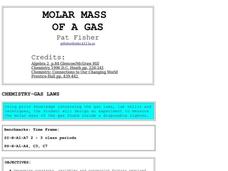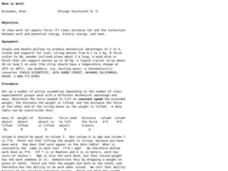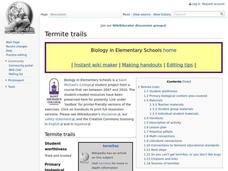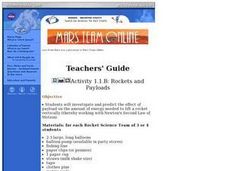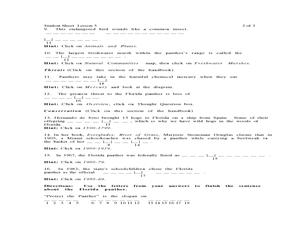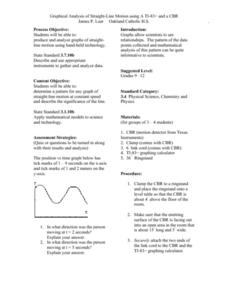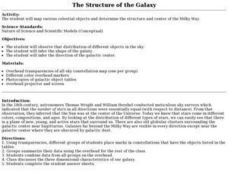Curated OER
Limiting Reagent
Students work in small groups with a small set of 8 nuts and 5 bolts to assemble into combinations of 1 nut: 1 bolt, and 2 nuts: 1 bolt. They explore the outcome and discuss. Then a student mixes two clear, colorless solutions together...
Curated OER
How Does our Heart Rate Change?
Students feel their pulse and describe it. They predict whether certain activities will increase or decrease their heart rates. Students use a heart rate sensor to determine resting heart rates and those after activity. In conclusion,...
Curated OER
Travel Mug Design
Learners create and develop a travel mug. They create visuals and a three dimensional infomercial. They apply an engineering design and demonstrate knowledge of thermodynamics involved in heat transfer. They illustrate Newton's Law of...
Curated OER
Molar Mass
Students apply the ideal gas law and Dalton's Law of Partial Pressure to develop an experiment which determine the molar mass of butane from disposable lighters. In small groups, they develop a procedure and have it approved before...
Curated OER
Chandra X-Ray Observatory
Students tour Chandra's top galactic X-ray images. In this Chandra X-Ray Observatory instructional activity, students play games and complete puzzles based on the Chandra Mission and X-Ray Astronomy. Students listen to pod casts,...
Curated OER
Helicopter Design Company
Learners test different designs of helicopters to determine what of the four designs will fall the slowest. In this helicopter instructional activity students complete an activity and fill out their worksheet.
Curated OER
Cabbage Juice Indicator
Middle schoolers experiment with household solutions and classify them as a base or acid. For this exploratory lesson students complete a lab where they test products to see if they are an acid or a base.
Curated OER
What is Work?
Students investigate the connection between work, potential energy, kinetic energy, and heat. In this physics lesson, students use pulleys to produce mechanical advantages and incline planes to demonstrate energy conversion.
Curated OER
Termite Trails
Students observe termite trail-following behavior. In this termite trails lesson, students draw a circle or other shape approximately eight inches across with a ball point pen. Teacher taps out termites into the circle and request that...
Curated OER
Scientific Method
Students explore the scientific method. In this scientific method lesson, students use information gathered from a "Seed Dispersal" lab done previously to complete a worksheet listing the steps of the scientific method.
Curated OER
Rockets and Payloads
Students investigate Newton's Second Law of Motion as they predict the effect of a payload on the amount of energy needed to lift a rocket vertically. The constraints of the weight of the equipment carried to Mars is compared to the...
Curated OER
Was Goldilocks Telling the Truth?
Sixth graders explore the movement of heat between objects. For this heat lesson, 6th graders use the scientific method to conduct guided experiments regarding conduction, convection, and radiation.
Curated OER
Panther Scavenger Hunt
Students research a website to learn about the Florida panther. In this animal research lesson plan, students use the scavenger hunt directions to search a website about Florida panthers. Students also solve word puzzles within the...
Curated OER
Graphical Analysis of Straight-Line Motion
Students investigate the concept of straight line motion. They determine the pattern and graph it looking for the motion maintained at a constant speed. Students also write a description of the significance of the line. The skill of...
Curated OER
The Structure of the Galaxy
Students infer the galaxy shape. In this structure of the galaxy lesson plan students observe the distribution of objects in the sky and answer questions.
Curated OER
How Can We Study the Differences in Animal and Plant Cells Using the Compound Microscope?
Students examine their cheek cells with a compound microscope. They identify different parts of the cell. They compare and contrast animal and plant cells with the microscope as well.





